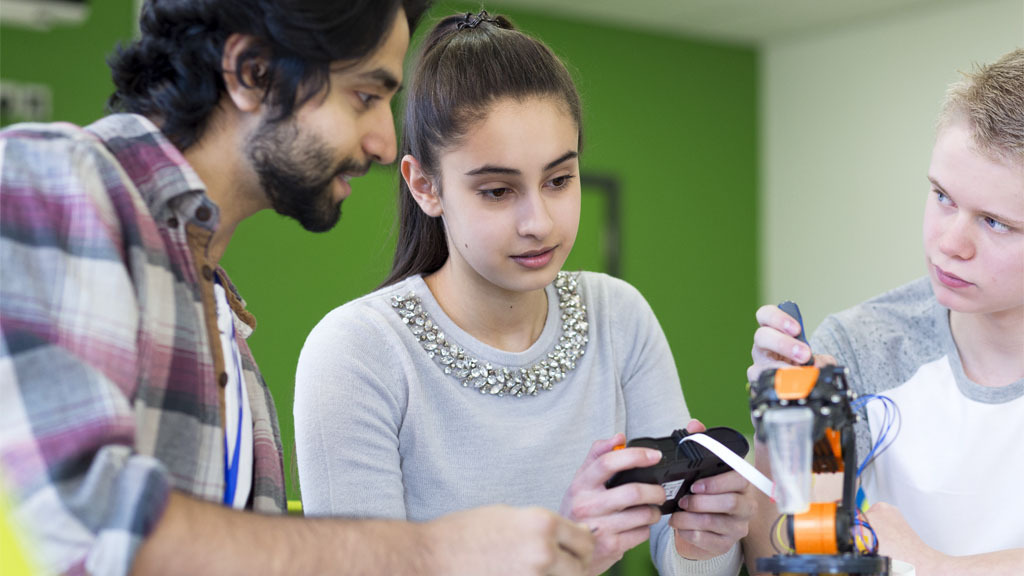Brief
The Engaging Value of Engineering Activities: Actionable Insights From Research
Think back to your earliest encounters with science. What do you remember? What made an impact that lasted into adulthood? Whatever comes to mind, it’s likely that the experience was fun and interesting, and was even better if it was collaborative and purposeful with meaningful relevance either to you personally or to wider society. Those are among the most valuable qualities of engineering activities, and our analysis of 263 research studies of engineering education conducted over the past two decades (Sneider and Ravel 2021) shows they are vital attributes both in school and settings outside the classroom. About two-thirds of the studies we examined took place in schools, mostly at the middle or high school level, and the other one-third was in out-of-school settings.
A very encouraging outcome from our review is that many methods for effective engagement hold true across varied activity themes and learning settings. Another major outcome was that these methods can yield memorable and compelling experiences, while also yielding effective learning of core ideas and practices of science and engineering. Additionally, these methods help build the lifelong 21st-century skills of collaboration, communication, and creativity, as well as persistence, motivation, self-confidence, and STEM identity.
With these benefits in mind, here are highlights of actionable methods that the evidence shows are effective in engaging students across a variety of age bands and learning settings.
Designing Effective Engineering Activities
Introducing an engineering challenge early and revisiting it throughout a science unit is more effective than using it only as a capstone activity at the end of a science unit. Starting with a meaningful, real-world challenge—such as designing, building, and testing a structure to withstand an earthquake or flood—can motivate students to learn the relevant science and mathematics, investigate how others have solved these problems, and engage their creativity.
A consistent finding in our data was the value of hands-on engineering activities. Hands-on engineering challenges stimulated interest in science and engineering, and helped students learn what engineering was all about.
Start student activities with an improvable design that helps the students become familiar with the materials and general principles of a project but offers opportunities for creative improvement. This method works best if the design challenge has a clear measurable goal, such as a wind turbine with the most electric power output or the strongest bridge at lowest cost.
Engaging youth in solving problems relevant to their communities. Many studies discuss various ways that youth—especially from underrepresented populations—can have a positive impact on their communities. One specific and widely adopted program is Engineering Projects in Community Service (EPICS), a mature program to support high school teachers in engaging their students in applying engineering and science to address community problems.
Instructional Planning
Collaboration with colleagues in mathematics, ELA, or art can greatly enhance science and engineering instruction. For example, two of the studies we reviewed used a fictional story to launch a design project by asking students how they might solve a problem posed in the story. This approach not only combines engineering with language arts, but it also helps students develop their abilities to define problems, sometimes called “problem scoping.”
Emphasize teamwork when planning activities. Engineering design is an eminently collaborative process. Not only is collaboration necessary to arrive at a better design, but it is also a means to cultivate 21st-century skills and contributes to a meaningful and enjoyable experience for students.
Support Networks
Meet with parents to help them understand their essential role in encouraging their children’s interest in STEM. Several of the studies revealed that advice from parents and caregivers was extremely important and could either encourage or discourage students’ pursuit of STEM fields.
Role models who matched students’ gender and ethnicity made a strong impression, helping students develop an identity as someone who could engage in engineering, both in school and as a possible career.
Mentors were especially helpful in encouraging youth from populations underrepresented in engineering to enroll in math, science, and engineering courses in high school. Several of the studies reported on the value of having college students who were engineering majors serve as mentors for middle school or high school youth.
The above methods are only a partial set of the teaching methods that we found to be effective. For more selections and depth, the complete review, Insights from Two Decades of P–12 Engineering Education Research, is available from the Journal of Pre-College Engineering Education Research (JPEER) and can be downloaded for free at: DOI https://doi.org/10.7771/2157-9288.1277.
Cary Sneider (carysneider@gmail.com) and Mihir Ravel are Visiting Scholars at Portland State University in Portland, Oregon, where Sneider is associated with the Educational Leadership and Policy Department at the College of Education and Ravel is associated with the Maseeh College of Engineering.
citation: Sneider, C., and M. Ravel. 2022. The engaging value of engineering activities: Actionable insights from research. Connected Science Learning 4 (4). https://www.nsta.org/connected-science-learning/connected-science-learning-july-august-2022/engaging-value-engineering
Engineering Instructional Materials Research STEM Teaching Strategies Informal Education



